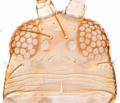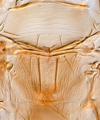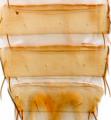Ewartithrips flavidus
Recognition data
Distinguishing features
Both sexes fully winged. Body, brownish yellow, legs paler, antennal segment I yellow II–VIII brown; fore wings pale. Head slightly wider than long, 3 pairs of ocellar setae present, pair III longer than, and arising on, lateral margin of ocellar triangle; postocular setae pair IV longer than diameter of posterior ocellus. Pronotum with 2 pairs of posteroangular setae, inner slightly longer than outer. Metanotum weakly reticulate, median setae longer than lateral pair and arising at anterior margin, paired campaniform sensilla present medially. Fore wing first vein with about 6 setae on distal half, second vein with 12 setae. Abdominal tergites with no sculpture medially, without ctenidia; tergite VIII with long regular marginal comb. Sternites without discal setae, sternite VII setae S2 arising at margin.
Male smaller than female; tergite IX with lateral marginal setae slender; sternites III–VII with small oval pore plate.
Related and similar species
The genus Ewartithrips was proposed for six species from California, although separation of this from the Mediterranean genus Tenothrips has been questioned (Bhatti, 2003). E. flavidus is structurally similar to E. ehrhornii, from which it apparently differs in body color.
Taxonomic data
Current valid name
Ewartithrips flavidus Nakahara
Original name and synonyms
- Ewartithrips flavidus Nakahara, 1996: 244
Family placement
Thripidae, Thripinae
Biological data
Life history
No information, presumably breeding in flowers.
Host plants
Collected from plants in several families, including Ceanothus (Rhamnaceae).
Tospoviruses vectored
None
Crop damage
None
Distribution data
Area of origin
Southwest USA
Distribution
California








